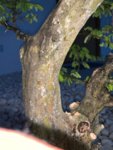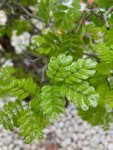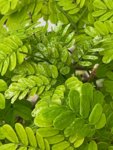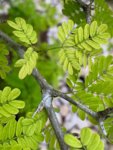You are using an out of date browser. It may not display this or other websites correctly.
You should upgrade or use an alternative browser.
You should upgrade or use an alternative browser.
I just saw this on my BRT - fungus, mildew? What I need to do?
- Thread starter janaiya
- Start date
Leo in N E Illinois
The Professor
- Messages
- 11,427
- Reaction score
- 23,608
- USDA Zone
- 5b
I don't know
Unless you start seeing changes in the leaves, I wouldn't worry.
Unless you start seeing changes in the leaves, I wouldn't worry.
janaiya
Yamadori
Ok, lets see what happens.
I think I might have fault in that. I misted the tree with a water and highly diluted fertilizer and I might not have diluted it enough. However only a few top leaves are like that, they might have been very delicate because just newborn.
I think I might have fault in that. I misted the tree with a water and highly diluted fertilizer and I might not have diluted it enough. However only a few top leaves are like that, they might have been very delicate because just newborn.
MHBonsai
Chumono
You are going to love this tree to death. Let it stabilize and recover and it will grow like wild. Get some more trees to keep you busy and let this one be. It's fine. 

janaiya
Yamadori
hahaha, you made me laugh. I already got another one, a pre bonsai with a good thick trunk and I think I will get another small one tomorrow, if I find one or I get one to grow in my garden.
And yes you are right. I haven't done anything since then and let him be. But I sit often on the stairs and look at him, he is so peaceful that he attracted a little Gecco who is there most of the time.
This tree looks just gorgeous and much more happier than a week ago.
And yes you are right. I haven't done anything since then and let him be. But I sit often on the stairs and look at him, he is so peaceful that he attracted a little Gecco who is there most of the time.
This tree looks just gorgeous and much more happier than a week ago.
Just like potato chips, or beer. You can't have just one.hahaha, you made me laugh. I already got another one, a pre bonsai with a good thick trunk and I think I will get another small one tomorrow, if I find one or I get one to grow in my garden.
And yes you are right. I haven't done anything since then and let him be. But I sit often on the stairs and look at him, he is so peaceful that he attracted a little Gecco who is there most of the time.
This tree looks just gorgeous and much more happier than a week ago.
janaiya
Yamadori
Carol you are absolutely right. 

janaiya
Yamadori
Hi everyone, an update on the white stuff on my leaves. It is spreading from leaves to leaves and it must be a kind of fungus because I see leaves affected what are not in the surroundings of the effected ones. I am getting concerned.
I am thinking of cutting those leaves off to see if it stops, thinking they affected leaves spread it to new ones. But then why certain leaves in the surroundings don't have it? Could it be something on the roots? Please anyone who has an idea or tip what to do please help!! Its not anything you can take off the leaves, it is inside the leaves. However the white stuff on the branches is outside of it (of course) but you can't scratch it off. Deficiency? Fungus? Maybe the organic fertilizer I am using, Soma cakes, however the first white leaves came out before I start using Soma cakes, so I don't think that's the cause.







I am thinking of cutting those leaves off to see if it stops, thinking they affected leaves spread it to new ones. But then why certain leaves in the surroundings don't have it? Could it be something on the roots? Please anyone who has an idea or tip what to do please help!! Its not anything you can take off the leaves, it is inside the leaves. However the white stuff on the branches is outside of it (of course) but you can't scratch it off. Deficiency? Fungus? Maybe the organic fertilizer I am using, Soma cakes, however the first white leaves came out before I start using Soma cakes, so I don't think that's the cause.







Attachments
Last edited:
leatherback
The Treedeemer
Hm.. Or you are lucky to have a random mutation and you have the first variegated BRT! 
If the plant is growing happily..
If the plant is growing happily..
0soyoung
Imperial Masterpiece
What do BRT leaves look like when old and about to be dropped?
janaiya
Yamadori
Mine are like yellowish green with a surrounding layer of yellow at the edges. Those with white stain are new leaves and they did not had those stains when they came out.
Estonio
Mame
Could it be oidium? Typically oidium looks more dusty.... I'm curious..
janaiya
Yamadori
I never heard of oidium. There is nothing to take off the leaves, no dust, no film, no powder, no insects
0soyoung
Imperial Masterpiece
Some mildews live strictly on the surface, but otherwise, fungi penetrate into the living tissues. This means that the only remedy is to remove affected leaves - they cannot be cured and are only sources of spores for further infection. Antifungal sprays will only kill spores and superficial fungi. So, if it is fungal,
Of course, look for other causes if this doesn't seem to be working.
- remove affected leaves
- spray an antifungal
- maybe use 2 tablespoons of 3% hydrogen peroxide (from the grocery/pharmacy) in a quart of water
- maybe Daconyl instead.
Of course, look for other causes if this doesn't seem to be working.
janaiya
Yamadori
Hm.. Or you are lucky to have a random mutation and you have the first variegated BRT!
If the plant is growing happily..
well not sure if still happy. But our climate atm is going up and down in temperature, it is 62 F/17 C and going down tonight, it rains since last night. I don't think it is a mutation
Definitely something what is not part of his happiness, because its taking over his body parts and feeding on it.
And since BRT's are pretty much pest resilient it might be really a fungus .
janaiya
Yamadori
Some mildews live strictly on the surface, but otherwise, fungi penetrate into the living tissues. This means that the only remedy is to remove affected leaves - they cannot be cured and are only sources of spores for further infection. Antifungal sprays will only kill spores and superficial fungi. So, if it is fungal,
Repeat as more affected leaves appear.
- remove affected leaves
- spray an antifungal
- maybe use 2 tablespoons of 3% hydrogen peroxide (from the grocery/pharmacy) in a quart of water
- maybe Daconyl instead.
Of course, look for other causes if this doesn't seem to be working.
so an antifungal is going to get rid of the fungus does not matter what fungus it is? And I have seen already other leaves infected as well, even if little I should take all those leaves off?
What about the branches, same thing? Do you think its related to it?
0soyoung
Imperial Masterpiece
Peroxide is broad spectrum, It is an indiscriminate antiseptic. Daconyl has some specificity, but low toxicity. Daconyl will leave a residue on the leaves that will kill incoming spores. Peroxide just acts on what is present at the time (I prefer to use it because it just oxidizes stuff and becomes nothing more than plain water).
Fungi acting on parts of the plant other than the leaves will act either in the phloem or in the xylem (maybe both). In the phloem you should observe withering of the bark that progresses downward, toward the roots (the direction phloem sap moves). In the xylem you will see the opposite - the usual result is the xylem gets clogged and the foliage above the point of infection suddenly withers, turns brown, and hangs on. Slowly thereafter (over the span of weeks) the bark withers. As far as I can tell from this thread, you have none of these symptoms, so I am not advising you to remove anything other than affected leaves.
Finally, I only know BRT by accounts such as this. I've never had one, nor am I particularly interested in having one. I am just speculating about a possible your problem (if it is indeed a problem). I think my proposal will do little harm if it is incorrect, but something positive otherwise.
Other possibilities are that your BRT has root problems which, if so, would most likely be from 'over watering' or compacted soil/media/substrate. If you dig your finger into the soil and it sticks to your finger, don't water. In fact, don't water until you see the foliage begin to droop. Note how the soil feels and use this as a guide to know when to water.
Smell the soil. If it stinks, it very well may have root rot, which is yet another kind of fungal infection and caused by over watering. If so, use the diluted peroxide solution the next time you correctly water the plant and maybe again the next time.
Lastly, the foliage in some pix looks to be pale but with dark green veins. This can be caused by mineral deficiency. Are you applying a fertilizer? What exactly is the soil/substrate/medium it is growing in and what is the pot made of (plastic, ceramic, concrete)?
Fungi acting on parts of the plant other than the leaves will act either in the phloem or in the xylem (maybe both). In the phloem you should observe withering of the bark that progresses downward, toward the roots (the direction phloem sap moves). In the xylem you will see the opposite - the usual result is the xylem gets clogged and the foliage above the point of infection suddenly withers, turns brown, and hangs on. Slowly thereafter (over the span of weeks) the bark withers. As far as I can tell from this thread, you have none of these symptoms, so I am not advising you to remove anything other than affected leaves.
Finally, I only know BRT by accounts such as this. I've never had one, nor am I particularly interested in having one. I am just speculating about a possible your problem (if it is indeed a problem). I think my proposal will do little harm if it is incorrect, but something positive otherwise.
Other possibilities are that your BRT has root problems which, if so, would most likely be from 'over watering' or compacted soil/media/substrate. If you dig your finger into the soil and it sticks to your finger, don't water. In fact, don't water until you see the foliage begin to droop. Note how the soil feels and use this as a guide to know when to water.
Smell the soil. If it stinks, it very well may have root rot, which is yet another kind of fungal infection and caused by over watering. If so, use the diluted peroxide solution the next time you correctly water the plant and maybe again the next time.
Lastly, the foliage in some pix looks to be pale but with dark green veins. This can be caused by mineral deficiency. Are you applying a fertilizer? What exactly is the soil/substrate/medium it is growing in and what is the pot made of (plastic, ceramic, concrete)?
janaiya
Yamadori
Peroxide is broad spectrum, It is an indiscriminate antiseptic. Daconyl has some specificity, but low toxicity. Daconyl will leave a residue on the leaves that will kill incoming spores. Peroxide just acts on what is present at the time (I prefer to use it because it just oxidizes stuff and becomes nothing more than plain water).
Fungi acting on parts of the plant other than the leaves will act either in the phloem or in the xylem (maybe both). In the phloem you should observe withering of the bark that progresses downward, toward the roots (the direction phloem sap moves). In the xylem you will see the opposite - the usual result is the xylem gets clogged and the foliage above the point of infection suddenly withers, turns brown, and hangs on. Slowly thereafter (over the span of weeks) the bark withers. As far as I can tell from this thread, you have none of these symptoms, so I am not advising you to remove anything other than affected leaves.
Finally, I only know BRT by accounts such as this. I've never had one, nor am I particularly interested in having one. I am just speculating about a possible your problem (if it is indeed a problem). I think my proposal will do little harm if it is incorrect, but something positive otherwise.
Other possibilities are that your BRT has root problems which, if so, would most likely be from 'over watering' or compacted soil/media/substrate. If you dig your finger into the soil and it sticks to your finger, don't water. In fact, don't water until you see the foliage begin to droop. Note how the soil feels and use this as a guide to know when to water.
Smell the soil. If it stinks, it very well may have root rot, which is yet another kind of fungal infection and caused by over watering. If so, use the diluted peroxide solution the next time you correctly water the plant and maybe again the next time.
Lastly, the foliage in some pix looks to be pale but with dark green veins. This can be caused by mineral deficiency. Are you applying a fertilizer? What exactly is the soil/substrate/medium it is growing in and what is the pot made of (plastic, ceramic, concrete)?
I made more pictures focusing on the trunk as well. have not seen that many stains yet on the trunk.Maybe that helps any further. Looks like white mold with all those stains everywhere. Not saying it is but mold does like that. What do you think? Do you think I can try brushing this stuff off? I have peroxide here but how I dilute it? How much water I dilute it with. What about organic baking soda?
The soil is nursery soil and not bonsai soil. The pot is a bonsai pot not glazed. I got the tree dec last year and I notized already a few of those stains on the trunk. Fertilizer I started using after I saw the first leaves changing color. Organic Sumo cakes in baskets to avoid wildlife eating them. It dissolves slowly. We water after measuring moist level with a meter. As soon as it goes to dry we water him. At the moment every other 3-4 days unless its sunny everyday and it dries out faster. Haven't had a look at the roots yet since the tree is fixed with the wire to the pot I did not wanted to disrupt the tree until its used to the new location.
I learned this tree is part of the legume family and I read somewhere that certain beneficial fungus are not good for it. But don't remember that link anymore. It was on some organic fertilizer link. I try to find right now. Thank you so much helping to figure this out.
SUMO CAKES :
Alfalfa meal, Bat guano, Blood meal, Bone meal, Earthworm castings, Feather meal, Fishbone meal, Fish meal, Gypsum, Hydrolyzed fish, Kelp (Ascophyllum nodosum), Kelp meal, Manganese sulfate, Protein hydrolysate, Rock phosphate, Sulfate of potash magnesia, Zinc sulfate.
MACRONUTRIENTS
N: Nitrogen
P: Phosphate
K: Potash
SECONDARY MACRONUTRIENTS
Calcium
Magnesium
Sulfur
MICRONUTRIENTS
Boron
Chloride
Cobalt
Copper
Iron
Manganese
Molybdenum
Sodium
Zinc
NATURAL MICROORGANISMS
MYCORRHIZAE
- Gigaspora margarita
- Glomus aggregatum
- Glomus brasilianum
- Glomus clarum
- Glomus deserticola
- Glomus etunicatum
- Glomus intraradices
- Glomus mosseae
- Glomus monosporum
- Laccaria bicolor
- Laccaria laccata
- Pisolithus tinctorius
- Rhizopogon amylopogon
- Rhizopogon fulvigleba
- Rhizopogon luteolus
- Rhizopogon villosuli
- Rhizopogon villosulus
- Scleroderma cepa
- Scleroderma citrinum
- Scleroderma geastrum
- Suillus granulatus
- Suillus punctatipes
- Trichoderma harzianum
- Trichoderma koningii
- Azotobacter chroococcum
- Bacillus amyloliquefaciens
- Bacillus azotoformans
- Bacillus coagulans
- Bacillus licheniformis
- Bacillus megaterium
- Bacillus pumilus
- Bacillus subtilis
- Bacillus thuringiensis
- Paenibacillus durum
- Paenibacillus gordonae
- Paenibacillus polymyxa
- Pseudomonas aureofaceans
- Pseudomonas fluorescens
- Saccharomyces cerevisiae






Attachments
Forsoothe!
Imperial Masterpiece
I'm only speculating, but it looks like a virus similar to Hosta Virus X which is not terminal, but degrades the health of Hosta and spreads by surface watering, and has intermediary hosts that do not show signs of it. It is also not curable, just like all other virus'. I would be worried.
Leo in N E Illinois
The Professor
- Messages
- 11,427
- Reaction score
- 23,608
- USDA Zone
- 5b
I'm not sure.
Powdery mildew, a fungi of genus Podosphaera or Erysiphe or Spherotheca. I've seen it on cucumbers, marijuana, & hops but have not heard that it would attack legume family trees.
It is more likely that fungus is not your main problem. The yellow and white in the leaflets also says to me you might be keeping it too wet. So I am seconding the concerns that it is a water issue.
Question, I live thousands of miles away from an ocean, so I never see salt water damage. Could your tree be getting salt spray from sea breezes?
Over watering can cause the yellow and white in the new growth. I would start with water, in terms of problem solving.
Powdery mildew, a fungi of genus Podosphaera or Erysiphe or Spherotheca. I've seen it on cucumbers, marijuana, & hops but have not heard that it would attack legume family trees.
It is more likely that fungus is not your main problem. The yellow and white in the leaflets also says to me you might be keeping it too wet. So I am seconding the concerns that it is a water issue.
Question, I live thousands of miles away from an ocean, so I never see salt water damage. Could your tree be getting salt spray from sea breezes?
Over watering can cause the yellow and white in the new growth. I would start with water, in terms of problem solving.
Similar threads
- Replies
- 4
- Views
- 207
- Replies
- 22
- Views
- 3K

![Image-1[5783].jpg Image-1[5783].jpg](https://www.bonsainut.com/data/attachments/212/212736-b3581ab124ae117eb7eeb12f44bdb911.jpg?hash=s1gasSSuEX)
![Image-1[5787].jpg Image-1[5787].jpg](https://www.bonsainut.com/data/attachments/212/212737-ec826dda6ffeccf492d033475897dfb9.jpg?hash=7IJt2m_-zP)
![InkedImage-1[5782]_LI.jpg InkedImage-1[5782]_LI.jpg](https://www.bonsainut.com/data/attachments/212/212745-41ecdce04b5a8b993b44ba6ea6a1c6a9.jpg?hash=Qezc4Etai5)
![InkedImage-1[5783]_LI.jpg InkedImage-1[5783]_LI.jpg](https://www.bonsainut.com/data/attachments/212/212746-143d59a4327b711f2e4cdef7ce42d5a8.jpg?hash=FD1ZpDJ7cR)



